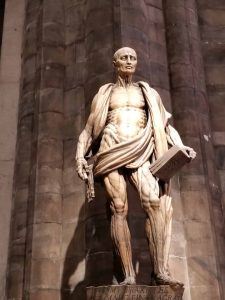Roslyn Bernstein in Guernica:
 A striking show of sculpture from 14th century Europe to the present, Like Life: Sculpture, Color, and the Body, currently on view at the Met Breuer, is full of surprises. How, the show asks repeatedly, did artists over the centuries depict the human body? Works of art that we expect to find in art museums are juxtaposed with much more jarring examples—in many cases, objects not traditionally seen as art at all. There are casts taken from real bodies; paint applied to works of art to imitate flesh tones. There are works with human blood, hair, teeth, and bones. One of the most shocking is The Digger (1857-1858) by Alphonse Lami, where the flayed figure’s (écorché) life-size body is so realistic that we see all the details of his musculature. He is leaning on his shovel but he hardly seems to be working. His body is painted red, with a sheen that radiates from what seem to be medically delineated tendons. The Met Breuer’s website reminds us that although most écorchés were created as anatomical teaching models for students of painting and sculpture, Lami “conceived of this figure as a genuine work of art, exhibiting it at the Parisian Salon of 1857 and signing its bronze base before it was subsequently displayed at the Académie des Sciences.”
A striking show of sculpture from 14th century Europe to the present, Like Life: Sculpture, Color, and the Body, currently on view at the Met Breuer, is full of surprises. How, the show asks repeatedly, did artists over the centuries depict the human body? Works of art that we expect to find in art museums are juxtaposed with much more jarring examples—in many cases, objects not traditionally seen as art at all. There are casts taken from real bodies; paint applied to works of art to imitate flesh tones. There are works with human blood, hair, teeth, and bones. One of the most shocking is The Digger (1857-1858) by Alphonse Lami, where the flayed figure’s (écorché) life-size body is so realistic that we see all the details of his musculature. He is leaning on his shovel but he hardly seems to be working. His body is painted red, with a sheen that radiates from what seem to be medically delineated tendons. The Met Breuer’s website reminds us that although most écorchés were created as anatomical teaching models for students of painting and sculpture, Lami “conceived of this figure as a genuine work of art, exhibiting it at the Parisian Salon of 1857 and signing its bronze base before it was subsequently displayed at the Académie des Sciences.”
The timing of my visit to Like Life was fortuitous. I was on my way to Italy with friends, one of them Professor Bert Hansen, a historian of medicine, whose research trip involved visits to anatomical theaters, medical museums, and archives, which housed collections that journalists rarely saw. Before Italy, though, I made a short stop in Pittsburgh and saw It’s all about ME, Not You, the Greer Lankton installation at The Mattress Factory on the city’s North Side. The bald-headed doll-mannequin on the posters for the Like Life show in New York was actually a Lankton work: a papier-mâché doll of the performance artist Rachel Rosenthal, which was once hung, fully clothed, in a store window in the East Village. Hairless, her rib bones protruding from her emaciated chest and harshly made up with red lipstick, arched eyebrows, and long red nails, the androgynous figure stares off into the distance with a stern, sad look. Here is another exhibit that focuses on the human body, in this case on Lankton’s, and on her life as a transgender woman.
More here.
